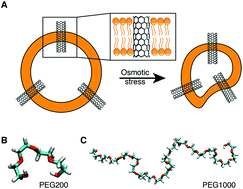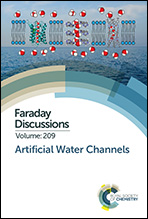Impact of PEG additives and pore rim functionalization on water transport through sub-1 nm carbon nanotube porins†
Abstract
Carbon nanotubes represent one of the most interesting examples of a nanofluidic channel that combines extremely small diameters with atomically smooth walls and well-defined chemical functionalities at the pore entrance. In the past, sub-1 nm diameter carbon nanotube porins (CNTPs) embedded in a lipid membrane matrix demonstrated extremely high water permeabilities and strong ion selectivities. In this work, we explore additional factors that can influence transport in these channels. Specifically, we use stopped-flow transport measurements to focus on the effect of chemical modifications of the CNT rims and chaotropic polyethyleneglycol (PEG) additives on CNTP water permeability and Arrhenius activation energy barriers for water transport. We show that PEG, especially in its more chaotropic coiled configuration, enhances the water transport and reduces the associated activation energy. Removal of the static charges on the CNTP rim by converting –COOH groups to neutral methylamide groups also reduces the activation energy barriers and enhances water transport rates.

- This article is part of the themed collection: Artificial Water Channels


 Please wait while we load your content...
Please wait while we load your content...
